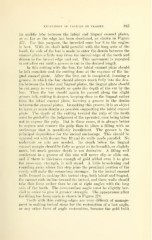Page 439 - My FlipBook
P. 439
EXCAVATION OF CAVITIES BY CLASSES. 195
its middle lobe between tlic labial and lingual enamel plates,
or as far as the edge lias been shortened, as shown in Figure
277. For this purpose, the inverted cone bur 8 in the engine
is best. With its shaft held parallel with the long axis of the
tootli, the side of the bur is made to enter the dentin between the
enamel plates a little way from the iueisal edge of the tooth and
drawn to the incisal edge and out. This movement is repeated
in cut after cut until a groove is cut to the desired length.
In this cutting with the bur, the labial enamel plate should
be left complete and the cutting done at the expense of the lin-
gual enamel plate. After the first cut is completed, forming a
groove, in which the bur should always reach fully into the den-
tin between the labial and lingual plates, the lingual plate should
be cut away to very nearly or quite the depth of the cut by the
bur. Then the bur should again be passed along the slight
groove left, cutting it deeper, keeping close to the lingual rather
than the labial enamel plate, forming a groove in the dentin
between the enamel plates. In making this groove, it is an object
to leave as much dentin as possible supporting the labial enamel
plate. The depth of the cutting toward the pulp of the tooth
must be guided by the judgment of the o^jerator, care being taken
not to expose the pulp. But in these cases, it is always better
to expose and remove the pulp than to place a filling with an
anchorage that is manifestly insufficient. The groove is the
principal dependence for the incisal anchorage. This should be
squared out with fissure bur 10 and its walls made parallel. No
undei'cuts or pits are needed. Its depth below the lingual
enamel margin should be fully as great as its breadth, or slightly
more, but much greater depth is not desirable. A filling well
condensed in a groove of this size will never slip or slide out,
and if there is thickness enough of gold added over it to give
the necessarjr strength, it will stand. A little broadening and
rounding away where this step joins the proximal portion of the
cavity will make the connection stronger. In the incisal enamel
walls formed in making this incisal step, both labial and lingual,
the enamel rods incline toward the incisal, and these walls should
take that form rather than be cut at right angles with the long
axis of the tooth. The cavo-surface angle must be slightly bev-
eled in order to give it greater strength. The appearance after
the filling has been made is shown in Figure 278.
Teeth with thin cutting edges are very difficult of manage-
ment in making incisal steps for the restoration of a lost angle,
or any other form of angle restoration, because the gold built


